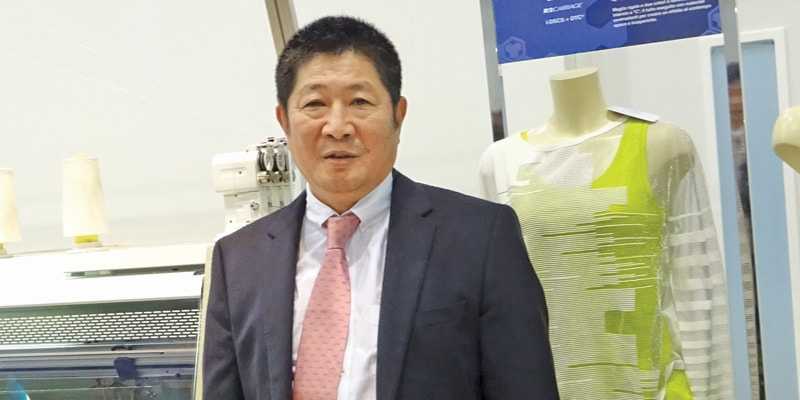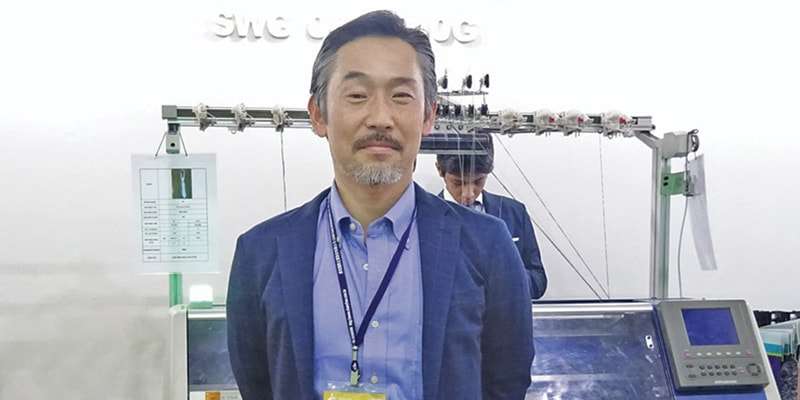
The data by the International Textile Manufacturers Federation shows that the global shipments of electronic flat knitting machines (used in fully-fashioned sweater production) were up by 31 per cent in 2014, of which 85 per cent made their way to Asia. If China grabbed a major share of the total shipment to Asia (accounting for 42 per cent), Bangladesh came a close second followed by Vietnam in third.

According to Shima Seiki, around 8,000 machines came to Bangladesh last year, which has emerged as a major player in the Bangladesh market, recording astonishing growth with unit sales doubling year over year. Highlighting the company’s expanding market in Bangladesh, Executive Director of Shima Seiki Mfg. Ltd., Ikuto Umeda , points out that Bangladesh is currently the fastest moving market for them as the industry is rapidly converting its hand flats into automated flats and with economic models to suit the entry point needs, Shima Seiki is poised to increase its market share significantly.
“Shima gives us good service and fantastic support. They not only trained our operators in-house but also took some of our people to Japan for training. Spare parts availability and the locally-based team of Japanese technicians are excellent,” underlined Alamgir Kabir, Managing Director, Best Wool Sweaters , one of the biggest sweater manufacturers in the country with 1,600 hand flats, 500 Shima Seiki and 400 Chinese semi-automatic flat knitting machines, vouching on Shima Seiki’s services and reliability. Kabir’s sentiment is reiterated even more strongly by Enayetuddin Md. Kaiser Khan, Managing Director of Sonia & Sweaters Limited , who has already installed 200 automatic machines from Shima Seiki with plans to open LC for 100 more soon, and who underlined, “Shima Seiki is the only one to work with for us,” the statement seconded by Delowar Hossain, Director – Raozan Sweaters Ltd ., who has installed 9 automatic jacquard machines in his facility recently.
The popularity of the Shima Seiki is also due to its robust training programmes for the operators and technicians. “We are providing basic training, intermediate training and higher training to our customers. We are even sending technicians of our customers to Shima Seiki, Japan for further training,” explained M. Shahabuddin, Managing Director of Pacific Associates , supplier of Shima Seiki machines in Bangladesh.
The brand’s flat knitting machine SSR112, which comes with Shima Seiki’s patented DSCS- Digital Stitch Control System technology, is the most popular. The machine treats each loop as digital data and thus is able to control the length and shape of every loop. Once a specific loop length is programmed, the machine continuously adjusts yarn feed and tension to yield consistency in every loop of each course, within ±1%. This results in production of knitwear with uniform dimensions and shaping, reducing the quality rejections due to size variations and deformed shape. The knitting machine, which comes in 7, 12, 14, and 16-gauge, also features Rapid Response Carriage System, allowing lower movement of inertia and quicker carriage returns.

ShimaKnitPLM, which is also the first PLM solution in flat knitting, is another offering worth mentioning. This unique intervention helps connect Shima Seiki products with the customer’s ERP and SCM core systems to provide high-level of traceability and eventually higher productivity through every stage of the value chain. “Manufacturers need to focus on these kinds of interventions to get better value and minimum rejections, and also meet on-time deliveries,” explains Tadanori Ueno, General Manager, Bangladesh Liaison Office – Shima Seiki Mfg. Ltd .
The company plans to make it loud and clear that it is not in Bangladesh to just sell machines, but rather help the garment manufacturers add value to their produce and production capabilities.
Apart from the range of flat knitting machines, Shima Seiki’s SDS design system is also said to be of big help to the apparel exporters of Bangladesh. “Exporters prepare samples based on the drawings sent by the buyers and then redesign it according to the buyers’ inputs. However, what they do not realize is that making a sample is more difficult than manufacturing 1,000 sweaters,” reasons Tadanori. By using the SDS design system, manufacturers can make virtual samples and also adjust the size of each part immediately, using the grading system, which helps them save a lot of time and money, spent on making samples.
In this race for automation, Chinese automatic machine manufacturers are a long way from catching up with the market leaders (Shima Seiki, Japan and Stoll, Germany). And now the stress is building up to increase capacities by producing high-end jacquard and intarsia sweaters by installing machines from Shima Seiki.
Further, taking note of the industry heading towards full automation with potential of customizable garments in the long term, Shima Seiki has also introduced seamless flat knitting machines. Shima Seiki’s WHOLEGARMENT takes away the need for skilled linking labour in sweater production by knitting fully finished, seamless garments while its WHOLEGARMENT model – MACH2XS, the company has introduced strategic machine linked to design systems to strengthen production.
Challenges for the sub sector
Regardless of the promises and prospects, sweater manufacturers in the country are constrained by diverse challenges, which are however not unique, they are in reality applicable on the entire industry spectrum like short supply of gas and electricity, infrastructural bottlenecks, business-unfriendly banking (non-availability of loans, high interest rates) for small and medium segments to name some while there are some, which are unique to the sweater industry. Foremost of these are workers’ absenteeism and limited skill set, limitations pertaining to efficiency and unethical competition.
Blessed with huge manpower but high rate of absenteeism during the festive seasons is something sweater manufacturers are hard-pressed to tackle. This not only affects productivity but also leads to serious business loss owing to delivery delays and cancellations. Automation although has helped address this to a great extent, lack of skilled manpower is still holding back sweater manufacturers from reaping full benefit of automation.
This has helped them cut manpower substantially while also increasing productivity. To counter this, sector experts suggest initiating knowledge-based education by updating the curriculum and opening sector-related departments in the universities.
Enhancement in knowledge base, they feel, would also help sweater manufacturers move up the value chain by producing fashionable products. Despite technical advances, the country is yet to be considered fully developed to compete in high-fashion sweaters, which has many brands and retailers availing limited support in terms of jacquards, with only some parts of the sweater made in critical designs, here.
Another interesting development is constraint due to rapid increase in capacities, compounded further by new players joining the fray to cash in the opportunities leading to ‘undercutting’. Spoilt for choice, there’s no blaming the buyers if they go to who offers the lowest price. A concerted marketing effort spearheaded by the Government in association with the industry bodies is the only way to control the malpractice and give a new direction to the industry.
Experts, as such, stress on a sustainable Government policy formulated in consultation with all the stakeholders, including industry people, to overcome the shortcomings and achieve desired results.

Post a Comment